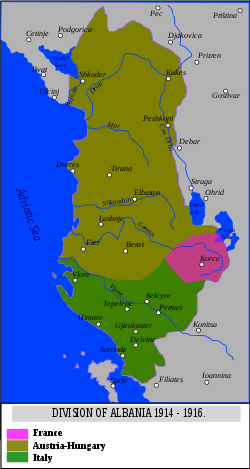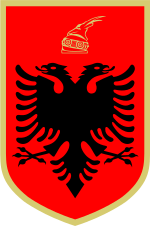Italian protectorate over Albania
The Italian protectorate over Albania was established by the Kingdom of Italy during World War I in an effort to secure a de jure independent Albania under Italian control. It existed from June 23, 1917 until the summer of 1920.
Albanian Republic Republika Shqiptare | |||||||||
|---|---|---|---|---|---|---|---|---|---|
| 1917–1920 | |||||||||
 | |||||||||
Motto: Atdheu mbi te gjitha "Homeland above all" | |||||||||
| Status | Protectorate of the Kingdom of Italy | ||||||||
| Capital | Valona | ||||||||
| Prefect | |||||||||
| Historical era | Interwar period | ||||||||
• Established | June 23 1917 | ||||||||
• Disestablished | 2 August 1920 | ||||||||
| ISO 3166 code | AL | ||||||||
| |||||||||
History
The Kingdom of Italy occupied the port of Vlorë on December 1914, but had to withdraw after the Austrian-Hungarian invasion in late 1915 - early 1916, and the fall of Durrës on 27 February 1916. In May 1916, the Italian XVI Corps, some 100,000 men under the command of General Settimio Piacentini, returned and occupied the region of southern Albania by the autumn 1916,[1] while the French army occupied Korçë and its surrounding areas on November 29, 1916. The Italian (in Gjirokastër) and French forces (in Korçë), according mainly to the development of the Balkan Front, entered the area of former Autonomous Republic of Northern Epirus (controlled by the Greek minority) in autumn 1916, after approval of the Triple Entente.

The establishment of the Autonomous Albanian Republic of Korçë was done on December 10, 1916 by French authorities with a protocol, according to which an autonomous province would be established on the territories of Korçë, Bilishti, Kolonja, Opar and Gora in eastern Albania.

On December 12, 1916, Italy asked for explanations from the Quai d'Orsay, through its ambassador, because the establishment of the Autonomous Albanian Republic of Korçë violated the Treaty of London.[2] Austria-Hungary used French precedent in Korçë to justify the proclamation of independence of Albania under its protectorate on January 3, 1917 in Shkodra.
The Kingdom of Italy did the same when proclaiming independence of Albania under its protectorate on June 23, 1917 in Gjirokastra.[3] General Ferrero proclaimed on that day the Italian Protectorate and the next weeks occupied Ioannina in Epirus.[4] Neither Great Britain nor France had been consulted beforehand, and they did not give any official recognition to the Italian Protectorate.[5]
This Albanian republic under the leadership of Turhan Përmeti, protected by 100,000 soldiers of the Italian Army, adopted officially a red flag with a black eagle in the middle, but raised a storm of protests even in the Italian Parliament [6]
.jpg)
In autumn 1918, the Italians expanded their Protectorate (without adding anything officially to Albania) to areas of northern Greece (around Kastoria) and western Macedonia (around Bitola), conquered from the Bulgarians and Ottomans. On September 25 the Italian 35 Division reached and occupied Krusevo deep inside western Macedonia.[7]
In October 1918, the Italian XVI Corpo d' Armata (nearly four divisions, with even 2 Albanian volunteers battalions) conquered all north-central Albania from the Austrians: on 10/14 Durres, the next day Tirane and on 10/31 Scutari; finally on November 3 even Ulcinj and Bar in actual coastal Montenegro.[8]
In November 1918, when World War I finished, nearly all what is now contemporary Albania was under the Italian Protectorate, after the French expedition withdrawal from the Korce area (France "officially" put an end to the Autonomous Albanian Republic of Korçë on December 10, 1918).
Since then and for nearly two years until summer 1920 the Italian Protectorate over Albania was administered by the Italian government: in a country that lacked nearly everything after centuries of Ottoman rule, were built 546 km of new roads, 110 km of new railroads, 3000 km of telegraph lines, 9 teleferics, a few hospitals and some modern administrative buildings.[9]
After World War I
A delegation sent by a postwar Albanian National Assembly that met at Durrës in December 1918 defended Albanian interests at the Paris Peace Conference, but the conference denied Albania official representation. The National Assembly, anxious to keep Albania intact, expressed willingness to accept Italian protection and even an Italian prince as a ruler so long as it would mean Albania did not lose territory.
But in January 1920, at the Paris Peace Conference, negotiators from France, Britain, Italy and Greece agreed to divide Albania among Yugoslavia, Italy, and Greece as a diplomatic expedient aimed at finding a compromise solution to the territorial conflict between Italy and Yugoslavia. The deal (with the Valona territory and areas of south-central Albania given to Italy) was done behind the Albanians' backs and in the absence of a United States negotiator.
This deal created huge anti-Italian resentment between many Albanians and in May 1920 the Italians (even because of demobilisation of their troops after World War I ended) withdrew to some important cities (Durazzo, Scutari, Tirane, Valona, Tepelani and Clisura) and their surrounding areas: successively were forced to fight the Vlora war. The revolutionary movements [10] in Italy made the presence of the last 20,000 soldiers of the Italian Army in Albania basically impossible.
On August 2, 1920 the Albanian-Italian protocol was signed, upon which Italy retreated from Albania (maintaining only the island of Saseno). This put an end to Italian claims for Vlora and for a mandate over Albania, rescuing the territory of the Albanian state from further partition.[11]
The desire to compensate for this retreat would be one of Benito Mussolini's main motives in invading Albania in 1939 [12]
See also
References
- "Armies in the Balkans 1914-18". Retrieved 27 December 2015.
- Popescu, Stefan. "Les français et la république de Kortcha (1916-1920)". France: Cairn info. doi:10.3917/gmcc.213.0077. Archived from the original on January 17, 2011. Retrieved January 17, 2011.
La signature de ce Protocole contrevient aux stipulations du traité de Londres ...Par conséquent, l'Italie demanda des explications au quai d'Orsay, par l'intermédiaire de son ambassadeur, le 12 décembre 1916.
- Jaume Ollé (July 15, 1996). "Republic of Korçë (1917-1918)". Archived from the original on January 12, 2011. Retrieved January 12, 2011.
On 23 June 1917, Italy proclaimed the independence of Albania under her protectorate, justifying this with the French precedent in Korçë. Austria-Hungary had done it before on 3 January 1917.
- "PRIMA GUERRA MONDIALE - LA STORIA CON I BOLLETTINI UFFICIALI". Retrieved 27 December 2015.
- "Southern Albania, 1912-1923". Retrieved 27 December 2015.
- "Southern Albania, 1912-1923". Retrieved 27 December 2015.
- (in Italian) War in 1918 Albania
- (in Italian) Italians in Albania during WWI: a forgotten war
- (in Italian) "Commissione d'inchiesta per l'impresa d'Albania del 1914-21"
- "Gli Italiani si ritirano dall'Albania". Retrieved 27 December 2015.
- "Albania - Albania's Reemergence after World War I". Retrieved 27 December 2015.
- "Albania in the Twentieth Century, A History". Retrieved 27 December 2015.
Bibliography
- (in Italian) Biagini, Antonello. Storia dell'Albania contemporanea. Bompiani editore. Milano, 2005
- (in Italian) Borgogni, Massimo. Tra continuità e incertezza. Italia e Albania (1914-1939). La strategia politico-militare dell'Italia in Albania fino all'Operazione "Oltre Mare Tirana" . 2007 Franco Angeli
- (in Italian) Bucciol, Eugenio. Albania: fronte dimenticato della Grande guerra. Nuova Dimensione Edizioni. Portogruaro, 2001 ISBN 88-85318-61-4
- Bushkoff, Leonard. Albania, history of. Collier's Encyclopedia. vol. 1. NY: P.F. Collier, L.P, 1996.
- Nigel, Thomas. Armies in the Balkans 1914-18. Osprey Publishing. Oxford, 2001 ISBN 1-84176-194-X
- Pearson, Owens. Albania in the twentieth century: a history (Volume 3). Publisher I.B.Tauris. London, 2004 ISBN 1-84511-013-7
- Steiner, Zara. The lights that failed: European international history, 1919-1933. Oxford University Press. Oxford, 2005.
- Stickney, Edith. Southern Albania. Stanford University Press. Stanford, 1929 ISBN 0-8047-6171-X
External links
- (in Italian) Italian Army in Albania in 1916 & 1917
- (in Italian) Italian Army in Albania in 1918
